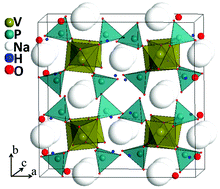Na2VO(HPO4)2: an original phase solved by continuous 3D electron diffraction and powder X-ray diffraction†
Abstract
The new phase Na2VO(HPO4)2 was synthesized by sodium/proton ion exchange between NaI and VO(H2PO4)2 in hexanol. The exchange of two protons by two sodium ions causes a structural reorganization leading to a new original phase. The crystal structure was solved by continuous 3D Electron Diffraction, consisting of recording a video in diffraction mode during the continuous sample holder rotation in order to acquire a complete dataset in a shortest time in order to avoid the deterioration of this electron beam sensitive material. The individual Electron Diffraction patterns were extracted from the video, processed by conventional electron diffraction crystallography programs (PETS, JANA2006) and the resulting structural model calculated by the charge flipping algorithm was refined from powder X-ray diffraction data. This material crystallizes in an orthorhombic unit cell in the Iba2 (45) space group, with the cell parameters a = 13.86852(19), b = 13.7985(2), c = 7.47677(9). Electrochemical studies show that up to 0.66 Na f.u.−1 could be removed from Na2VO(HPO4)2.



 Please wait while we load your content...
Please wait while we load your content...